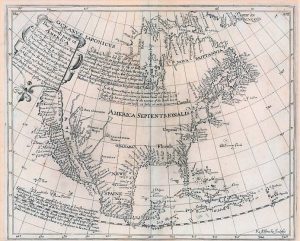Living in the great state of Arizona, I see people travel frequently between Phoenix and Southern California. According to the map app on my phone, the California border is only 3 hours away if I drive west on Interstate 10. Plus, my phone gives me written and audio turn-by-turn instructions with a detailed map of the road I will travel. This clarity and simplicity is available to everyone today with a web-enabled mobile device. However, getting an accurate map and directions to California was not always so easy.
During the 16th and 17th century, many people believed that California was an island. This belief was established because the Baja peninsula extends roughly 1,000 miles south from today’s state of California. Thus, Spanish explorers concluded in the early 1600s that California was cut off from the mainland. Click the image below to enlarge.
Throughout the 1600s, European countries differed on whether California was or was not an island. By 1622, a British mathematician published an influential article with a map of California as an island, but Dutch cartographers (people who produce maps) continued to print maps with California as a peninsula. By 1638, all European cartographers supported the island theory and Nicolas Sanson, geographer to the King of France, confirmed in 1650 that California should be depicted as an island on all maps.
In 1705, Eusebio Kino, a Jesuit priest, led an overland expedition across the Sea of Cortez and wrote a report with a map that cast serious doubt on the belief that California was an island. After continued exploration, King Ferdinand VI of Spain issued a decree in 1747 stating that California was officially not an island. Yet, despite this decree, cartographers did not completely abandon this belief for another century. (1)
While early explorers had difficulty creating geographical maps, each of us often struggle today to create accurate mental maps. These maps – also known as mental models – represent images, assumptions, and stories of ourselves, organizations, and every aspect of the world. These mental maps exist in our long-term memory and at the sub-conscious level. As a result, our maps are often untested and unexamined and influence our short-term perceptions and everyday reasoning.
The challenge with following these maps is that our world constantly changes. What customers want, what competitors will do, how the marketplace will evolve, and what technology will exist continues to change and evolve. So how can you recognize and surface your mental maps to examine and determine when your maps become outdated?
I recommend the Ladder of Influence and the ORJI Model as two tools to help you expose and test your mental maps. These tools were developed and refined by some of the most respected leaders in the field of organizational change including Ed Schein, Chris Argyris, Peter Senge, and Rick Ross.
- Ladder of Inference – Describes a common mental ladder that we climb starting with observable data and experiences at the first rung and then we climb to translate that data into meaning, assumptions, conclusions, beliefs, and actions based on the beliefs. Because the original data is selective and based on observations, our ending actions may be based on misguided beliefs.
- ORJI Model – This acronym is formed by the steps of Observation, Reaction, Judgement, and Intervention which takes place in our mind and affects our behavior. We make an observation, react emotionally to that observation, analyze and make a judgement based on the observation and feelings and finally intervene by taking some action.
In our daily fast-paced work we nearly always race from observation up to action in a split second without recognizing our reaction or the meaning we place on the data we observe. This happens because mental maps have such a strong influence on how we think and act. However, wise leaders will walk down the rungs of the ladder and revisit the initial observation step to determine if their actions and mental maps are outdated and based on misguided beliefs.
So how does this apply to leading change? When our organizations experience transformational change, we must learn new ways of thinking, communicating, and working. To adopt these changes requires more awareness, reflection, and openness to rewrite our mental maps. Otherwise, we become defensive towards the change, hold on to our outdated mental maps, and miss the opportunity grow and progress.
So next time you face organizational change, remember the map of California and avoid the same mistakes made by the early European explorers. Remember how we often make observations based on incomplete data that we form into assumptions and how those conclusions become beliefs and actions from inaccurate maps. Instead, slow down and walk down the Ladder of Inference and ORJI model to help your organization rewrite your mental maps and chart your new course.
Sources:
- https://www.wired.com/2014/04/maps-california-island/
- Overcoming Organizational Defenses – Facilitating Learning by Chris Argyris
- Process Consultation Revisited by Ed Schein
- Fifth Discipline Fieldbook by Peter Senge, Art Kleiner, Charlotte Roberts, Richard Ross, and Bryan Smith
- https://purl.stanford.edu/sy409bk9698
- https://purl.stanford.edu/cb303zr7917
- https://searchworks.stanford.edu/view/zb871zd0767
- https://west.stanford.edu/news/island-anything-surrounded-difference-thoughts-maps-and-history



There is some indirect evidence pointing to the fact that California was depicted as an island on charts and maps (at least, the one captured aboard a Spanish Galleon by the Dutch in 1620) to negate Francis Drake’s 1579 claim of “New Albion” on the NW Coast of North America. Hernando Cortes had landed at the southern end of the Baja California peninsula in 1535, claiming the land for Spain. When the Manilla Galleons first started sailing in 1565, the first land they spotted on their return across the Pacific was Cape Mendocino and vicinity, so the name “California” stretched northward by this time at least to there (California as an island maps from 1656 on extended the island’s boundaries even further north to approximately the latitude of modern day Salem, Oregon). By the depiction of California as an island, everybody would know that it was Spain’s claim, not that of Elizabethan England’s.